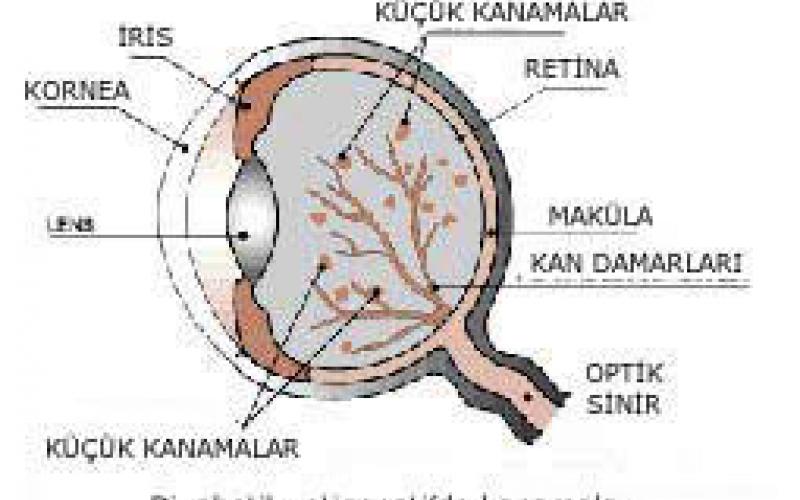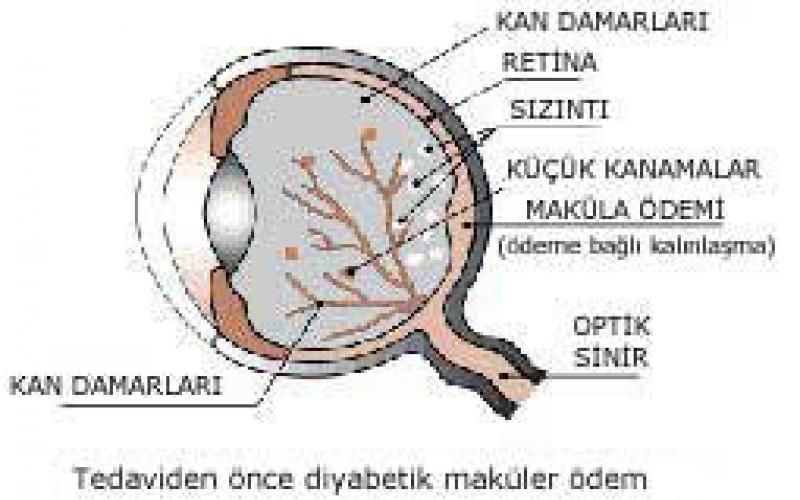Diabetes and Eye
If you have diabetes, you need an eye check for good eye health.
Diabetes leads to some eye disorders in patients. For example, eye pressure (glaucoma) and cataract (blurring of the lens) occur twice as often in diabetic patients. However, the most important eye disorder is diabetic retinopathy. Diabetic retinopathy (DR in short) is the leading cause of vision loss worldwide. Every year, it leaves 25,000 diabetics blind in the world. The risk of blindness is 25 times higher in diabetics than in non-diabetics (Prevent Blindness America) .Diabetic retinopathy is mild or severe in about half of diabetics.
Therefore, multicentre studies carried out by several clinics together examine how the disease progresses, risk factors and treatment methods.
DR incidence (Type I diabetes) It is 7% for 0–4 years, 25% for 5–9 years, 60–71% for 10–16 years, 90% for 17–50 years. Retinal disorder in diabetes is due to changes in the retinal blood circulation. Leakage or bleeding from the vessel wall leads to this condition. First, spot and larger bleedings, micro-aneurysms (bubbles) and vascular leaks are seen in the retina of the eye. Then they lead to the development of new capillaries prone to bleeding. This vascular development occurs after approximately 13–15 years. Between 26 and 50 years, 26% of patients have developed ophthalmological findings. After the age of 15 years, the frequency of DR in type I diabetes will increase rapidly due to the hormonal effects of puberty.
Type II diabetes The incidence of DR is also directly proportional to the duration of the disease; however, sometimes DR may be the first sign of the disease. This is because diabetes has persisted for years before it is clinically understood. Again, DR may have appeared before the diagnosis of diabetes has yet been established.
Some important points can be summarized as follows:
Hypertension Control:
In this clinical study, for insulin-dependent diabetics, elevated systolic (large) blood pressure indicates the possibility of DR, while elevated diastolic (small) blood pressure indicates that DR is progressing. In patients with chronic hypertension, the veins will become narrow, which will disrupt the blood build up of the retina and ensure new vessel formation. Besides, paralysis, heart and kidney diseases are frequently observed in diabetic patients and blood pressure control is also important.
Control of Blood Sugar:
Even though there is no definite conclusion on this subject today, it may be useful to strictly regulate blood sugar at the beginning of diabetes. However, after exceeding the return point, there are so many hormonal, biochemical and hemodynamic effects that no strict sugar regulation can reverse the case, but slows its progression.
Pregnancy:During pregnancy, the formation of new capillaries in the retina is accelerated and the control of sugar becomes difficult. Therefore, eye examination should be repeated every 2 months during pregnancy. Fluorescein angiography has not proven to have a negative effect on the baby, but should be avoided as much as possible.
Treatment:
The main treatment of diabetes-induced retinopathy is laser. Leaking bubbles are closed and the non-feeding parts of the eye are destroyed by laser beams since the eye remains bloodless. Although laser treatment does not bring back the lost vision, it significantly reduces visual loss in 2 years (50%). Your phycisian will tell you whether or not the laser treatment is needed, and if necessary, the eye vessels will be subject to x-ray to guide the laser treatment. (Flourescein Angiography = FFA) Vitreoretinal surgery may be necessary if there is widespread hemorrhage that prevents vision in the eye or if new vessel formations have contracted and removed the retinal layer.


The aim of all these interventions is only to minimize the permanent visual retinal loss that may occur. Also, eye pressure should be evaluated as a whole at every examination. Eye pressure is controlled with various drugs and surgeries, and necessary recommendations are made. Cataracts are twice as common in diabetic patients as in diabetic patients. In some cases, it is necessary to remove the cataract for laser treatment of the eye. Besides, since DR can accelerate after cataract surgery, great importance should be paid to controls.

WHAT SHOULD I DO?
Even if your vision level does not decrease, your eye may have started bleeding. It is impossible for the patient to notice and go to the doctor unless the bleeding and leaks due to diabetes are at the point where we call the macula (yellow spot) that provides sharp vision. The only thing that can be done is to have an eye examination at least every 6 months, although there are no symptoms at regular intervals. If an abnormality is detected in the eye ground, the examination intervals will be shortened and if necessary, laser treatment will be recommended. Other eye disorders will also be discussed in examinations.

